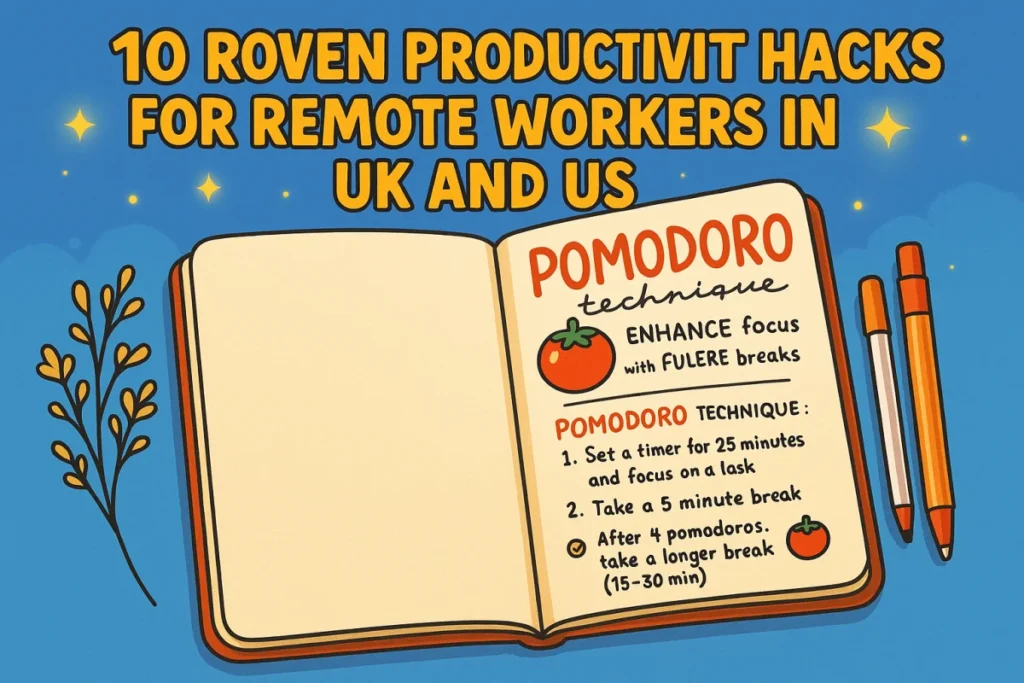Ever felt like your to-do list is multiplying while your attention span is shrinking? You’re not alone. In a world of constant pings and notifications, staying focused is a real challenge. That’s where the Pomodoro method comes in – a simple yet powerful productivity timer strategy gaining traction among students and professionals across the UK and US.
Whether you’re drowning in coursework or juggling back-to-back Zoom meetings, this focus technique is helping thousands reclaim their time and sanity.

What is the Pomodoro Method?
Created by Francesco Cirillo in the late 1980s, the Pomodoro technique is based on a simple principle: work in focused sprints followed by short breaks. Each session, or “Pomodoro,” is typically 25 minutes long, followed by a 5-minute break. After four Pomodoros, take a longer 15-30 minute break.
Why it works:
- Reduces mental fatigue
- Increases accountability
- Encourages single-tasking
- Creates a sense of urgency without stress
Tools like TomatoTimer and Focus To-Do make it easy to implement.
The Rise of the Pomodoro Technique in the UK & US
From London college libraries to New York co-working spaces, the Pomodoro method is fast becoming a daily staple. But why has this method seen such a surge in these regions?
Post-Pandemic Productivity Crisis
The pandemic blurred the lines between work and rest. According to a Harvard Business Review study, remote workers put in longer hours but felt less productive. Pomodoro’s structure provides much-needed boundaries and helps reintroduce rhythm to scattered schedules.
Digital Distraction Epidemic
Research by RescueTime shows that the average knowledge worker spends only 2 hours and 48 minutes of true productive time each day. The Pomodoro technique offers a solution: manageable time blocks to laser-focus, while still allowing for short, restorative breaks.
Rise in Neurodiversity Awareness
Many students and professionals in the UK/US with ADHD or executive dysfunction report improved task initiation and completion using Pomodoro. The method’s time-boxing approach resonates with how neurodivergent brains operate.
Real-Life Pomodoro Stories: UK & US Users Share Their Experience
🇬🇧 Sarah, Law Student, London
“Before Pomodoro, I felt constantly overwhelmed. I used to pull all-nighters, but now I study in 25-minute blocks. My retention has improved and I no longer dread revision. I even gamify it with a Pomodoro app that tracks my streaks.”
🇺🇸 Jason, Software Engineer, San Francisco
“I was skeptical. But I tried Pomodoro during a sprint and noticed my bug resolution rate went up. Now, my team even has a shared timer during work hours. We treat it like a silent focus club.”
🇬🇧 Priya, Remote Marketer, Manchester
“Working from home blurred all boundaries. The Pomodoro method gave me back my evenings. I set 8 Pomodoros a day and stick to it. The structure feels like a virtual manager keeping me in check.”
Applying Pomodoro: Practical Tips for UK & US Users
Getting Started
- Pick Your Timer: Use free tools like Pomofocus.io or a simple kitchen timer.
- Set Daily Intentions: List tasks to complete each Pomodoro.
- Track Progress: Use a notebook or app to mark completed sessions.
Tailoring for Students
- Pair Pomodoros with subjects (e.g., 2 for math, 1 for reading)
- Use longer breaks to review flashcards or take a walk
- Join virtual “study with me” Pomodoro YouTube streams
Tailoring for Employees
- Align Pomodoros with meetings and task blocks
- Use breaks to stretch, hydrate, or log notes
- Encourage team-wide adoption for focused sprints
Table: Student vs. Employee Pomodoro Usage
| Criteria | Students (UK/US) | Employees (UK/US) |
|---|---|---|
| Common Session Length | 25 min study, 5 min break | 25 min task, 5 min break |
| Main Tools Used | Forest, Study Bunny, YouTube Live | Pomofocus, Toggl, Trello |
| Motivation Techniques | Gamified streaks, social study | Team accountability, daily goals |
| Common Challenges | Procrastination, burnout | Zoom fatigue, task overload |
| Benefits Reported | Improved retention, reduced stress | Faster task completion, less fatigue |
Expert Insight: Why It Works So Well
Dr. Gloria Mark, a professor of informatics at UC Irvine, notes that attention spans have drastically shrunk in the digital age. She supports time-boxed methods like Pomodoro for “cognitive resetting,” helping the brain switch off and recharge between tasks.
According to LinkedIn’s Global Talent Trends, employees today value productivity and well-being. The Pomodoro technique delivers on both fronts: measurable output with built-in self-care.
Pitfalls to Avoid
Despite its strengths, Pomodoro isn’t a silver bullet. Avoid these mistakes:
- Rigid Scheduling: Life happens. Don’t stress if you miss a Pomodoro.
- Overestimating Tasks: Break complex work into multiple Pomodoros.
- Ignoring Breaks: Skipping breaks kills the method’s effectiveness.
Conclusion: Why You Should Try Pomodoro Today
Whether you’re a college student navigating exams or a professional drowning in deadlines, the Pomodoro method offers a simple but powerful solution. It turns the overwhelming into the manageable and helps you stay focused in a world built to distract.
The beauty lies in its adaptability – anyone with a timer can try it. Start with just one Pomodoro and build from there. Your productivity, mental clarity, and peace of mind will thank you.
Ready to focus smarter, not harder? Try the Pomodoro method today and share your experience in the comments. Explore our other productivity hacks and sign up for our weekly newsletter for more focus-boosting tips.



